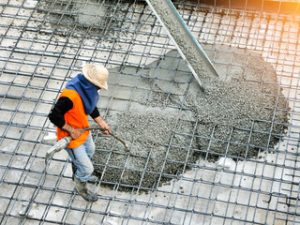Concrete Franklin TN is the foundation material for the world’s buildings going back to Roman times. It is also a key ingredient in pavements, roads and driveways.

Concrete is a mixture of aggregates, water and cement. Engineers play with the proportions to achieve a soft balance between quality and workability. This is what makes concrete so powerful and reliable.
Concrete is one of the strongest construction materials, able to withstand heavy loads and environmental wear. It is also highly versatile and can be molded into different shapes to fit various project needs. As a result, it is used in a wide variety of large-scale and commercial construction projects across the globe.
The strength of concrete is determined by the amount of cement mixed with aggregates and water. The aggregates are typically crushed stone, larger gravel or pea gravel, and smaller sand or silica. Cement acts as the binding agent and activates during hydration to create the dense material we know as concrete. The resulting mixture is then poured into forms, which give it the shape and form of the desired structure, and then cured for several days to reach its full strength.
There are a number of different grades of concrete, each with its own specific properties. For example, high-strength concrete is often utilized in load-bearing applications like bridges and skyscrapers. This type of concrete contains steel reinforcement bars that enhance its tensile strength and allow it to resist the compression that would otherwise rupture the concrete.
Low-strength concrete is more often used in domestic flooring, like garage or workshop floors and foundation slabs. This grade of concrete has a strength of 20 Newtons after 28 days and is ideal for these purposes.
In recent years, new types of concrete have been developed that use industrial waste, such as ground vehicle tyres or glass, as an alternative to traditional aggregates. These new materials, known as geopolymer or polymer concrete, have shown improved performance compared to conventional concrete in terms of chemical resistance and durability.
The strength and durability of concrete make it a popular choice for a range of infrastructure projects, including highways, roadways, and parking lots. Its resistance to harsh weather conditions and vehicular traffic is why many businesses choose it as the material for their commercial paving projects. In addition, concrete’s compressive strength makes it a great material for constructing dams and other massive infrastructure.
Durability
Concrete is a tough, durable construction material that’s used extensively in the modern world. Its durability makes it a great choice for roads, highways and other large infrastructure projects that require enduring strength and resilience. Concrete also holds up well to repeated exposure to freezing and thawing cycles, deicing chemicals and environmental wear and tear.
Concrete can be molded into a variety of shapes to suit different building designs and applications. Its versatility allows it to be poured into sidewalk forms, high-rise walls and foundation footings. Alternatively, it can be poured into trenches and tunnels to form underground structures. Concrete can even be shaped into blocks, slabs and pillars to create homes, offices, shopping centres and stadiums.
The durability of concrete is largely dependent on the water-cement ratio, aggregate type and environment during mixing and curing. It is critical that the concrete mixture has just enough water to ensure that all the aggregate particles are coated with cement paste and that the spaces between them are filled. The mix must also be liquid enough to pour and spread easily.
A concrete’s durability is also determined by its composition, structure and reinforcement. It is important that the steel bars that are used in concrete are properly placed and supported so that they can resist bending and stretching.
It’s also important to note that concrete is 10 times weaker in tension than it is in compression, so unless it is heavily reinforced with steel, it can crack or snap under certain conditions. To counter this, engineers use a system of reinforcing rods that are inserted into the concrete during construction to create strong, flexible connections.
The durability of concrete is a crucial factor when choosing the materials to use in infrastructure and construction. Its ability to withstand significant loads and stresses and its resistance to harsh weather conditions and chemical actors make it a great choice for roads, highways, bridges and dams. Concrete is also a good choice for commercial parking lots and recreational courts because it offers longevity and minimal maintenance requirements.
Workability
Concrete’s workability is a measure of how easily it can be mixed, placed, consolidated and finished without losing strength or quality. This workability is influenced by the aggregate type and size, the amount of water used in the mix, and the addition of chemical admixtures. A poorly mixed or sized batch can result in a harsh and difficult to finish mixture, while the addition of an appropriate admixture, such as air-entraining agent or glossy pozzolanic material, can increase its workability.
A high-workability concrete is fluid and self-compacting, making it ideal for use in complex or congested areas where external compaction is impractical. This type of concrete is also popular for use in pumped concrete applications where the mixture must flow to hard-to-reach areas. Concrete with low workability is stiff and can be difficult to place, compact or finish, but it’s commonly used in building foundations where a higher level of durability is needed.
The initial workability of concrete is impacted by the type and richness of the cement, the temperature of the mix, and the environment in which it is poured. For example, hot outdoor temperatures cause the water in concrete to evaporate more quickly, resulting in a decrease in its initial workability over time. This is known as slump loss and can be prevented by adding a concrete retarder to the mix.
In general, a higher water content in a concrete mix increases its workability. This is because the water acts as a lubricant between the aggregate particles, allowing them to move more freely. However, too much water can lead to segregation and a decrease in strength.
Other factors influencing the workability of concrete include its thickness, the method of mixing, and the aggregate-to-cement ratio. The use of an air-entraining agent, for example, can help reduce internal friction by increasing the surface area of the aggregates, which makes it easier for them to move around. Chemical admixtures, such as plasticizers and water-reducers, can also enhance the workability of concrete by reducing its water-cement ratio without affecting its strength. This is particularly useful when a thicker section of concrete is required because it allows for a more uniform mix and less chance of segregation.
Environmental Impact
Concrete is the second most consumed material on Earth, yet the concrete industry accounts for 7% of global anthropogenic carbon dioxide emissions, double that of the aviation industry1. Fortunately, there are many ways individuals can reduce their impact. These include reducing aggregate use, specifying lower-emission concrete, and utilising smarter construction practices.
The environmental impact of concrete largely depends on the volume and type of aggregate used, as well as the cement used to bind the materials together. The most significant environmental impact of concrete is attributed to the production and transport of Portland cement, accounting for over 90% of concrete’s total carbon footprint. Thankfully, the availability of alternative cementitious materials (SCMs) can significantly mitigate these emissions. SCMs like fly ash, blast-furnace slag, and silica fume have been shown to reduce GWP through their pozzolanic reaction. However, the utilisation of SCMs in concrete results in increased impacts related to ecotoxicity and acidification potential, which may be partially mitigated through the use of advanced sorting technologies that can enhance the quality of recycled aggregates.
A new concrete innovation is a carbon capture process, which removes CO2 from the air during the curing of concrete and stores it in the form of a solid, allowing buildings to achieve net-zero energy status. However, this technology is still under development and requires close collaboration between producers and users to reach its full potential.
Using lower-emission concrete, such as ACC or mineral carbonation, will substantially lower the overall environmental impact of concrete. However, the most effective way to further improve a concrete mix’s sustainability profile is to limit its cement content. This can be achieved by increasing the proportion of SCMs or utilising a blend of these with clinker at 30% or 40% replacement levels, as defined in Australia’s Green Star criteria. The use of these lower-emission concrete mixtures also has the added benefit of lowering thermal stress on structures, which can lead to cracking and premature failure. This can be reduced by implementing a controlled temperature curing system, such as with heat mats or blankets, and conducting regular quality-control testing to ensure proper curing conditions.

